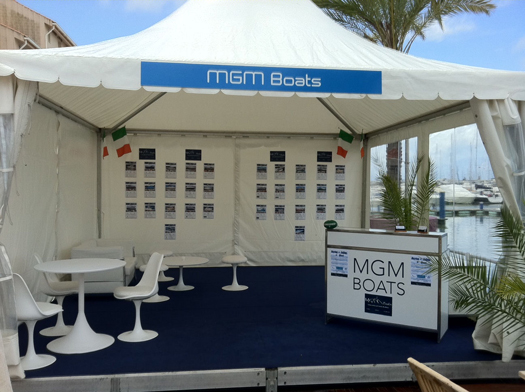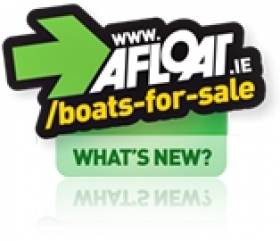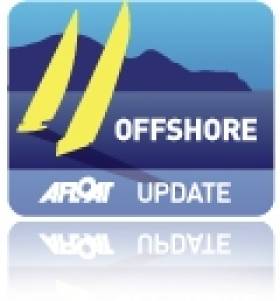Displaying items by tag: BJ Marine
Beneteau Oceanis 38 & 55 Generate Cruising Interest for BJ Marine
#bjmarine – Last season saw Irish boat sales firm BJ Marine deliver several debut models to new Irish owners and that trend looks set to continue after September's Southampton Boat Show this season too.
The Irish boat dealer attended the show with a six strong team from the Malahide, Greystones, Bangor and Malta offices present on the Beneteau, Fairline, Sea Ray and Greenline stands.
The Beneteau brand was to the fore in Southampton with yachts exhibited ashore and motor boats afloat.
The new models, the Oceanis 55 and in particular, the Oceanis 38 are making big inroadsinto the modern cruising market and BJ report both designs will have Irish owners for the 2014 season.
There will also be the first Oceanis 48 in to Ireland in 2014. The MC5 (pictured) also created interest with owners recognising a step up in quality, finish and performance.
Fairline debuted the Squadron 48 and Targa 48 with orders for both and BJ Marine do have availability for several models for the 2014 season.
One noticeable point for the BJ Marine team in Southampton was the demand for quality used boats. There are both international and domestic buyers awaiting the right boat.
BJ Marine's James Kirwan told Afloat.ie "There are new boats coming home, we have marine finance available, we are taking trade ins, there is demand for used boats and the 2013 summer showcased our marine environment better than ever, bring on 2014".
Contact James Kirwan at 01 8061560
Denis O'Brien Buys Former BJ Marine 'Docklands' Warehouses for €1m
#QUAYCAPITAL - Businessman Denis O'Brien has spent about €1 million on the purchase of two campshire warehouses, fronting the south quays of the Liffey in Dublin's Docklands quarter.
The campshires are the stretches of land between the quay and road on both the north and south quays in Dublin, which in times past, were thronged with warehouses during the days when cargoships used to sail this far up the Liffey.
Mr O'Brien is expected to spend almost as much again on the upgrading and refurbishment work before renting the buildings as restaurants or for other retail uses.
The detached buildings at Sir John Rogerson's Quay date from the 1880s and were handed over to Nama after the Government decided to dissolve the disgraced Dublin Docklands Development Authority.
Selling agent CBRE said most of the considerable number of inquiries it received about the former BJ Marine warehouses came from the catering industry because of their unique quayside location in an area where a large number of professional workers are employed.
"There is obviously a growing demand for services in what has now become a vibrant business district," says Niamh Sheehan, who handled the sales. For more on this story, the Irish Times has a report.
Future of Graving Docks in Limbo as Plot 8 is Transferred to NAMA
#INLAND WATERWAYS - The site of the former graving docks at Grand Canal Dock has been transferred to NAMA in a deal which frees the Dublin Docklands Development Authority (DDDA) from a €29 million plus bank guarantee.
Plot 8 at Sir John Rogerson's Quay is one of a suite of nine sites that have been transferred to the Government's 'bad bank' in a negotiated loan settlement that extricates the Docklands body from loan guarantees given by banks that financed the "disastrous" Dublin Glass Bottle site deal in 2006.
Sites handed over in the deal include the former 'U2 Tower' and the historic BJ Marine premises on the banks of the Liffey, as well as the aforementioned Dublin Glass Bottle site.
The Dublin branch of the Inland Waterways Association of Ireland (IWAI) had been hoping to embark on a restoration of the graving docks at Plot 8 to their former working order (a detailed history of the docks and restoration plans is available HERE).
This project had been given the blessing of the DDDA and Waterways Ireland, which owns the freehold lease on the site, with a view to its restoration helping to fund the Ulster Canal scheme.
However with the transfer of the DDDA's interest in the site to NAMA, the authority has now withdrawn permission for the IWAI to do any restoration work, leaving the future of the graving docks in limbo.
Healthy Discounts Give Irish Boat Sales a Lift
Any upturn couldn't come quick enough though. The Irish Marine Federation (IMF) is counting the cost of recession that has reduced its membership by up to two thirds as marine firms closed their doors.
"For the first time in three years I'm seeing fresh enquires and importantly new blood coming into Irish boating, said Bernard Gallagher of BJ Marine in Malahide, north Dublin.

Boat dealers are offering substantial discounts
The new confidence in Irish boat buyers is primarily being seen in the sailing boat market.
One of the most accurate barometers of marine leisure activity, some dealers are reporting a return business levels not seen for three or four years.
"We've just sold a lovely 38-footer in to Howth and we've more sales in the pipeline said" Gallagher.
Other dealers confirm the same saying there is definitely a positive mood among buyers to go the extra step in the sales process.
It's quite a turnaround because up until very recently, dealers admit there was 'no boat buying mood at all'.
Ironically though after such poor sales at home there's now a real shortage of boats for sale here because over the past few years a lot of Irish boat stock was sold abroad.
"We badly need boats for our brokerage listings", says Gallagher who also operates branches in Belfast and Malta.
Many say sales will never get back to the dizzy heights of 2006 but for now good product ranges at the right place plus a splash of Easter sunshine is helping to move things at least a step in the right direction.
Irish dealers have been resourceful in finding markets abroad and an example of this is Dun Laoghaire dealer MGM boats who has just returned from the Portuguese boat show where there was positive vibes in Villamoura despite the recent bailout there too!

The MGM Boats Stand at the recent Villamoura Show
Afloat.ie: Beneteau Antares 6
Beneteau Celebrates Success Down Under
Following the historic success of 2009 when two FIRSTs occupied the first two places in the overall IRC and ORC rankings, the 2010 race has seen another Beneteau double as two Firsts won their class in the 600-mile offshore fixture.
True to its reputation, the 2010 race took place in extreme conditions with winds reaching 45 knots and the suspense maintaine right to the end.
The well-named FIRST 45 Victoire won the race in IRC2. The FIRST 40 Paca was the winner in IRC3.
The Irish agent for Beneteau is BJ Marine.
Fairline Wales Dealer Appointed
Luxury motor yacht manufacturer, Fairline Boats has recently appointed a dedicated dealer for the Wales and the North of England regions. Blue Water Marine joins the Fairline authorised dealer network, trading as Fairline Wales, and will offer sales and after-sales services, including boat maintenance and park & launch from its Hafan Pwllheli Marina location in North Wales. The Fairline Ireland Dealer is BJ Marine.
Commenting on the appointment, Sales Director of Blue Water Marine, Steve Bridgett says, "Blue Water Marine has a proud history of offering customers the very best in new and used boats, and we feel that the addition of Fairline motor yachts will further complement this. The Fairline brand is well received in the region and we are excited about introducing the new Squadron 41, which we think will be a real winner with our customers."
Blue Water Marine employs twenty members of staff including fully trained and skilled technicians, and also runs an on-site chandlery and parts department. The company has been in operation for 15 years and recently announced plans to expand its existing showroom to include additional sales offices and an all-new customer lounge.
Fairline Wales will be present at all the major UK boat shows including the PSP Southampton Boat Show in September and the London International Boat Show in January. For further information about Fairline Wales, please visit www.fairline.com/wales.
For further information about the Fairline range and the many shows and events the company attends worldwide, please visit www.fairline.com.
Fairline Wales contact details:Address: Pwllheli Marina, Pwllheli, Gwynedd, LL53 5YT, WalesTel: +44 (0)1758 614600Email: [email protected]
New Fairline Ireland Dealer Appointed
Luxury motor yacht manufacturer, Fairline Boats has recently appointed BJ Marine to represent the brand in Ireland. The company will trade as Fairline Ireland and undertake sales and service operations of the previous authorised Fairline dealer for the region. With offices located in both Dublin and Belfast, BJ Marine is ideally located to serve customers throughout Ireland.
Bernard Gallagher, Managing Director, BJ Marine comments, "Fairline is a prestigious and well recognised brand, with many followers here in Ireland. We have already received high levels of interest from existing and new customers, particularly for the soon to be launched Squadron 41 flybridge motor yacht which is perfectly suited for our waters."
With over 30 years experience in boat sales and service, BJ Marine offers customers a full after-sales service at its offices at Malahide Marina, Dublin and Bangor Marina, Belfast, which both also offer boatyard and lift facilities. Customers have access to local services such as training and marine finance, offered by the other marina tenants.
The new dealer will be attending all major boat shows in the UK, including the PSP Southampton Boat Show in September and London International Boat Show next January. For further information about Fairline Ireland, please visit www.fairline.com/ireland.
For more information about the Fairline range and the many show and events the company attends worldwide, please visit www.fairline.com.
Fairline Ireland contact details:
In Dublin:
Address: Malahide Marina, Malahide, Co Dublin.
Tel: +353 1 8061560
Email: [email protected]
In Belfast:
Address: Bangor Marina, Bangor, Co. Down BT205ED, Northern Ireland.
Tel: + 44 2891 271434
Email: [email protected]
Skiffs, short-handers and sharing
In this week's podcast we speak to Ross Killian about stepping back into an Olympic campaign and into a 49er for the first time. We profile a J105 that's ripe for short-handing in our boat of the week slot, and talk to Richard Glynn of Kilrush about the joys of boat sharing.





































































